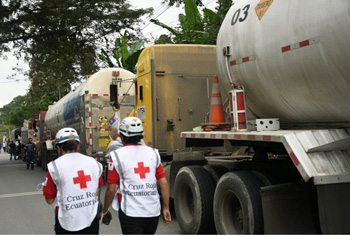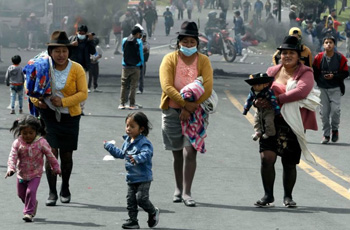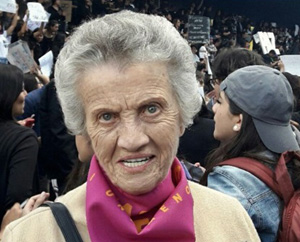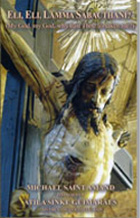International Affairs
 |
 |
 |
 |
 |
 |
 |
Communist-Narco Violence in Ecuador
As in October 2019, Ecuador is once again the victim of an indigenous uprising promoted by the left, manipulated by Rafael Correa. Correa, as the reader may remember, is the former socialist president who ruled Ecuador for 10 years. The recent subversion was directed by the indigenous leader Leonidas Iza, who is also a Marxist and an admirer of Sendero Luminoso (Luminous Path), a terrorist Peruvian group of Maoist inspiration.
 The chaos in which Ecuador has been living for the last 17 days has been architected and financed – according to sectors of the press, intellectuals and members of the government – by the drug trafficking cartel, which is a close ally of Corrêa. The goal was to seize power and depose Guillermo Lasso's government at any price. This would explain the brutal violence the indigenous have unleashed on the country.
The chaos in which Ecuador has been living for the last 17 days has been architected and financed – according to sectors of the press, intellectuals and members of the government – by the drug trafficking cartel, which is a close ally of Corrêa. The goal was to seize power and depose Guillermo Lasso's government at any price. This would explain the brutal violence the indigenous have unleashed on the country.
During these 17 days, the indigenous – led by terrorists specialized in urban guerilla warfare – caused severe damage to the country, engaged in several confrontations with the police and the army, and cut off the flow of food and goods supply vehicles in several cities, mainly in Quito.
The highway blockades resulted in food shortages in the city, to the point that for the first time in the history of Ecuador supermarket shelves were empty, causing shortages, price increases and speculation for goods.
Ecuador is self-sufficient in fuel, and oil is the foundation of the State budget. Thus the reader can understand what it means when one thousand oil wells were taken over by the indigenous; the equipment was either damaged or stolen, causing the suspension of operations.
As I write this report on June 30 there are only 10 days of reserve oil and barely two more days of full supply.
There has also been a shortage of natural gas for domestic use with the consequent inconvenience for families in the country.
These riots have caused countless losses both to private and public companies amounting to more than US $500 million.
These are some noticeable points of the urban guerilla tactics:
To take power
During these days of highway blockades, the government has called for dialogue. But there was no meeting of the two sides because the indigenous leader Iza would not attend.
Taking advantage of the fear and panic in the people, representatives of the indigenous in Congress, along with their Socialist allies, tried to impeach President Guillermo Lasso. After a few attempts they did not reach the necessary majority of 92 votes; however, they did get a count as high as 80. Therefore, the rioters did not reach their main goal and the plan has been abandoned for now.
So, how did the left gain all the possible advantages in this carefully planned assault? Representatives of the clergy entered the picture, proposing to be the mediators. The indigenous accepted the offer.
The ensuing dialogue took place at the Basilica of the National Vow, a prestigious church in the historic center of Quito. President Lasso – a member of Opus Dei which is strongly influenced by the clergy – ended by accepting practically all of the demands of the terrorists. Thus he projected the image of a weak President predisposed to give in to pressure from the left.
Of course the CONAIE (Confederation of Indigenous Nationalities), seeing the weak position of the government, raised new demands, the most important being a call of full amnesty for the criminals who carried out acts of vandalism and attacked the forces of order (there were 99 wounded soldiers and one killed). The indigenous leaders demanded that legal criminal proceedings should not be made against any of the "protesters."
 During these meetings – and perhaps counting on these concessions – indigenous attacked a military escort to a fuel convoy on June 28. Sergeant José Chimarro was killed and many soldiers wounded.
During these meetings – and perhaps counting on these concessions – indigenous attacked a military escort to a fuel convoy on June 28. Sergeant José Chimarro was killed and many soldiers wounded.
President Lasso left the negotiation table and affirmed he would not dialogue with Leonidas Iza, because he did not represent the Indians, but only his own ideological agenda.
Indigenous uprisers also prevented oxygen trucks to reach the hospitals. In face of this situation, Iza declared that he would allow those trucks to pass through the indigenous barriers… He also declared that he would allow food to reach the cities suffering shortages.
So, one can ask, who in practice is governing Ecuador?
Leonidas Iza appears as the all powerful dictator. In reality he is the puppet of Corrêa, who is a fugitive from the Ecuadorian Justice living in Belgium.
Today, June 30, it was announced that a dialogue table would be re-established with the Ecuadorian Episcopal Conference playing the mediator role.
If an agreement is reached, President Guillermo Lasso will continue to govern, at least until this duo of dictators decide otherwise…


Leonidas Iza in red, the Marxist leader of the Indians
During these 17 days, the indigenous – led by terrorists specialized in urban guerilla warfare – caused severe damage to the country, engaged in several confrontations with the police and the army, and cut off the flow of food and goods supply vehicles in several cities, mainly in Quito.
The highway blockades resulted in food shortages in the city, to the point that for the first time in the history of Ecuador supermarket shelves were empty, causing shortages, price increases and speculation for goods.
Ecuador is self-sufficient in fuel, and oil is the foundation of the State budget. Thus the reader can understand what it means when one thousand oil wells were taken over by the indigenous; the equipment was either damaged or stolen, causing the suspension of operations.
As I write this report on June 30 there are only 10 days of reserve oil and barely two more days of full supply.
There has also been a shortage of natural gas for domestic use with the consequent inconvenience for families in the country.
These riots have caused countless losses both to private and public companies amounting to more than US $500 million.
These are some noticeable points of the urban guerilla tactics:
- The indigenous mobs invade the cities with a front line of women carrying children to prevent the police from attacking them or if the police attacks, to make them victims;
- After the rioters create chaos, the police are obliged to use tear gas; then the insurgents "counter-attack" with great violence to "protect their women and children;"
- At this point, trained urban guerilla activists go against the police with "improvised" weapons: stones, rockets, wood batons. As they progress they
set fire to tires, wood and clothing that they gather into piles;
- If any agitator is wounded by the police, he is carried in triumph as a victim of the repressive State. If he is fatally wounded, then their ideal is reached; the "victim" is transformed into
a martyr;
- We note here five allies in these organized manifestations:
- The "pacific' indigenous who march in the front lines with women and children;
- The violent trained urban guerilla corps that follow behind and engage in violent action when the police respond;
- The communication teams that compose and spread the news, giving their communist version of the events;
- The big media that blows its trumpets to favor the demands of the protesters as well as a great number of Internet sites that promote these communist manifestations;
- The progressivist clergy who give all possible ideological and logistic support to the activists, hosting them in its religious houses.

Indigenous women & children are used as shields
for urban guerrilla purposes

Sister Elsie Monge participating in the manifestations: an enthusiastic defender of Iza
To take power
During these days of highway blockades, the government has called for dialogue. But there was no meeting of the two sides because the indigenous leader Iza would not attend.
Taking advantage of the fear and panic in the people, representatives of the indigenous in Congress, along with their Socialist allies, tried to impeach President Guillermo Lasso. After a few attempts they did not reach the necessary majority of 92 votes; however, they did get a count as high as 80. Therefore, the rioters did not reach their main goal and the plan has been abandoned for now.
So, how did the left gain all the possible advantages in this carefully planned assault? Representatives of the clergy entered the picture, proposing to be the mediators. The indigenous accepted the offer.
The ensuing dialogue took place at the Basilica of the National Vow, a prestigious church in the historic center of Quito. President Lasso – a member of Opus Dei which is strongly influenced by the clergy – ended by accepting practically all of the demands of the terrorists. Thus he projected the image of a weak President predisposed to give in to pressure from the left.
Of course the CONAIE (Confederation of Indigenous Nationalities), seeing the weak position of the government, raised new demands, the most important being a call of full amnesty for the criminals who carried out acts of vandalism and attacked the forces of order (there were 99 wounded soldiers and one killed). The indigenous leaders demanded that legal criminal proceedings should not be made against any of the "protesters."

Trucks with oxygen prevented from reaching hospitals
President Lasso left the negotiation table and affirmed he would not dialogue with Leonidas Iza, because he did not represent the Indians, but only his own ideological agenda.
Indigenous uprisers also prevented oxygen trucks to reach the hospitals. In face of this situation, Iza declared that he would allow those trucks to pass through the indigenous barriers… He also declared that he would allow food to reach the cities suffering shortages.
So, one can ask, who in practice is governing Ecuador?
Leonidas Iza appears as the all powerful dictator. In reality he is the puppet of Corrêa, who is a fugitive from the Ecuadorian Justice living in Belgium.
Today, June 30, it was announced that a dialogue table would be re-established with the Ecuadorian Episcopal Conference playing the mediator role.
If an agreement is reached, President Guillermo Lasso will continue to govern, at least until this duo of dictators decide otherwise…

Posted July 1, 2022
______________________
______________________
 Volume I |
 Volume II |
 Volume III |
 Volume IV |
 Volume V |
 Volume VI |
 Volume VII |
 Volume VIII |
 Volume IX |
 Volume X |
 Volume XI |
 Special Edition |


